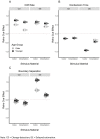A diffusion model analysis of age and individual differences in the retro-cue benefit
- PMID: 37833420
- PMCID: PMC10575881
- DOI: 10.1038/s41598-023-44080-z
A diffusion model analysis of age and individual differences in the retro-cue benefit
Abstract
The limited capacity of working memory (WM) constrains how well we can think and act. WM capacity is reduced in old age, with one explanation for this decline being a deficit in using attention to control WM contents. The retro-cue paradigm has been used to examine the ability to focus attention in WM. So far, there are conflicting findings regarding an aging deficit in the retro-cue effect. The present study evaluated age-related changes and individual differences in the retro-cue effect through a well-established computational model that combines speed and accuracy to extract underlying psychological parameters. We applied the drift-diffusion model to the data from a large sample of younger and older adults (total N = 346) that completed four retro-cue tasks. Retro-cues increased the quality of the evidence entering the decision process, reduced the time taken for memory retrieval, and changed response conservativeness for younger and older adults. An age-related decline was observed only in the retro-cue boost for evidence quality, and this was the only parameter capturing individual differences in focusing efficiency. Our results suggest that people differ in how well they can strengthen and protect a focused representation to boost evidence-quality accumulation, and this ability declines with aging.
© 2023. Springer Nature Limited.
Conflict of interest statement
The authors declare no competing interests.
Figures





Similar articles
-
Is refreshing in working memory impaired in older age? Evidence from the retro-cue paradigm.Ann N Y Acad Sci. 2018 Jul;1424(1):175-189. doi: 10.1111/nyas.13623. Epub 2018 Apr 10. Ann N Y Acad Sci. 2018. PMID: 29635867
-
In search of the focus of attention in working memory: 13 years of the retro-cue effect.Atten Percept Psychophys. 2016 Oct;78(7):1839-60. doi: 10.3758/s13414-016-1108-5. Atten Percept Psychophys. 2016. PMID: 27098647 Review.
-
An age-related deficit in preserving the benefits of attention in working memory.Psychol Aging. 2019 Mar;34(2):282-293. doi: 10.1037/pag0000326. Epub 2019 Jan 14. Psychol Aging. 2019. PMID: 30640485
-
Orienting Attention to Auditory and Visual Short-term Memory: The Roles of Age, Hearing Loss, and Cognitive Status.Exp Aging Res. 2020 Jan-Feb;46(1):22-38. doi: 10.1080/0361073X.2019.1693008. Epub 2019 Nov 21. Exp Aging Res. 2020. PMID: 31750789
-
Behavioral and Neural Markers of Flexible Attention over Working Memory in Aging.Cereb Cortex. 2016 Apr;26(4):1831-42. doi: 10.1093/cercor/bhw011. Epub 2016 Feb 9. Cereb Cortex. 2016. PMID: 26865653 Free PMC article.
Cited by
-
Parameter estimation of hyper-spherical diffusion models with a time-dependent threshold: An integral equation method.Behav Res Methods. 2025 Sep 10;57(10):283. doi: 10.3758/s13428-025-02810-3. Behav Res Methods. 2025. PMID: 40931252 Free PMC article.
References
-
- Griffin IC, Nobre AC. Orienting attention to locations in internal representations. J. Cogn. Neurosci. 2003;15:1176–1194. - PubMed
-
- Landman R, Spekreijse H, Lamme VAF. Large capacity storage of integrated objects before change blindness. Vision Res. 2003;43:149–164. - PubMed
-
- Souza, A. S., & Oberauer, K. In search of the focus of attention in working memory: 13 years of the retro-cue effect. Atten. Percept. Psychophys. 1–22 (2016). - PubMed
Publication types
MeSH terms
LinkOut - more resources
Full Text Sources

